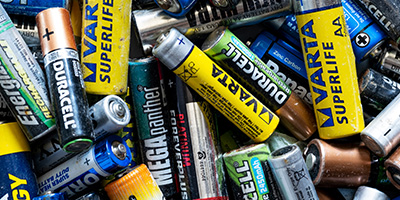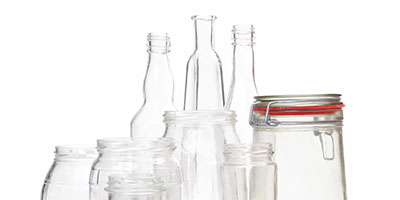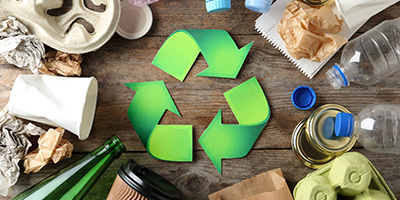How to Recycle Glass at Home the Right Way

The Complete Guide to Recycling Glass
You’ve just finished your favorite salsa and are about to drop the glass jar in the recycling bin, but a few questions pop into your head. Is this the best way to recycle glass? Do you have to wash it first? What happens to recycled glass?
Fortunately, you won’t have to stop and think about recycling that jar for much longer. Keep reading to find the answers to all of your questions about how to recycle glass.
Frequently Asked Questions About Glass Recycling
Should Glass Be Recycled?
Yes. Glass is infinitely recyclable. For every ton of glass recycled, more than a ton of natural resources are saved, including 1,300 pounds of sand, 410 pounds of soda ash, 380 pounds of limestone and 160 pounds of feldspar, according to Keep America Beautiful.

“Glass recycling has a direct impact on climate change. By using recycled glass in container glass manufacturing and fiberglass insulation, [carbon dioxide] emissions are reduced and energy savings are realized. This is because recycled glass melts at a lower temperature than virgin materials. Further, if recycled glass is used in place of virgin materials, it is conserving natural resources. Although glass is inert, it does not belong in landfills. Glass never fully degrades. It never wears out and can be re-used endlessly.”
Laura Hennemann, VP, Marketing & Communications, Strategic Materials
Is All Glass Recyclable?
No, not all glass products are recyclable. Glass used in food packaging, such as iced tea bottles and salsa jars, is recyclable and should not be tossed in the garbage.
Glass cookware and storage containers are not recyclable, however. Neither are most types of lightbulbs, unless otherwise stated by your recycling provider. Glass recyclers consider these items contaminants and they should be kept out of your recycling bin.
Types of glass that can’t be recycled:
- Window panes.
- Mirrors.
- Automotive glass.
- Crystal.
- Ceramics, including cookware and decorative pieces.
- Glass that is heat resistant, like Pyrex.
- Lightbulbs, unless specifically accepted by your recycler.
“Check your local stores like Home Depot, Lowes, grocery stores and local recycling centers for recycling options” for these items, says Laura Hennemann at Strategic Materials.

“Always consult your municipality to see what the collection requirements are (if your municipality is with Recycle Coach, it’s as easy as checking your app). Some like bottles sorted or only accept glass containers of a certain color. There are often rules about recycling broken glass, too. Most cities won’t accept it as it presents a hazard to collection personnel (this isn’t always true, though). At the end of the day, each jurisdiction has its own rules determined by what is accepted at their MRF [Material Recovery Facility].”
Recycle Coach
Not sure what to throw away and what to recycle? Check out our guide on What Not to Recycle!
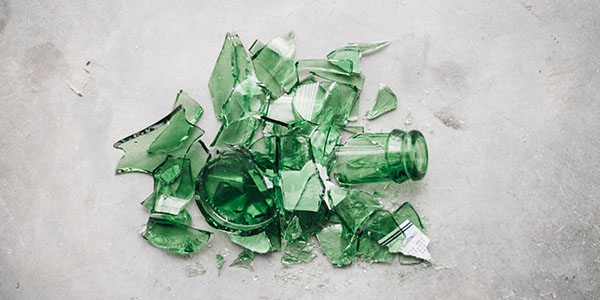
Is Broken Glass Recyclable?
Broken glass is recyclable and is preferred in some areas. Some other providers may not accept it because the broken pieces could be considered a potential hazard to workers who collect your recycling.
Always check with your local provider to make sure they allow the type of glass you’re recycling, including broken glass.
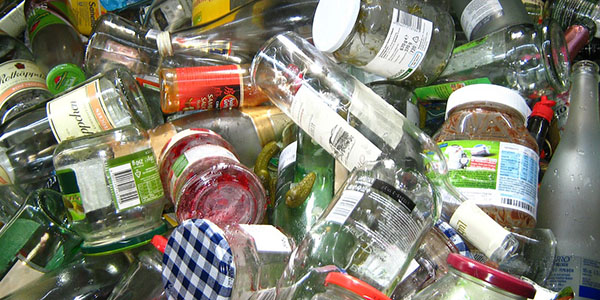
How Do You Prepare Glass for Recycling?
When recycling glass at home, it’s good to rinse out the containers before placing them in your bin. This will reduce food contamination and keep odors to a minimum.
“Also, if you have the time or desire, removing labels is extremely helpful. These typically burn off in our process but helps to keep emissions down and keep the glass as clean as possible for recycling,” says Laura Hennemann at Strategic Materials.
Make sure to remove any lids that are not made of glass, including corks.
What Happens to Glass After It Is Recycled?
When you recycle glass jars or bottles, they are sent to a processor where they are cleaned, sorted and crushed. Your recycled glass then becomes cullet, the industry term for furnace-ready recycled glass.
Once prepared, the cullet is sold to manufacturers where it can be used to create new glass jars, bottles, fiberglass products or even used in place of sand in a variety of industrial applications.

“There is a hierarchy for the use of recycled glass in our country. The use that has the most value is glass made back into [glass] bottles, container glass being made back into containers. The percentage of recycled content in containers is around 33 percent. Next highest value use is fiber glass.”
Mary Ann Remolador, Assistant Director Northeast Recycling Council, Inc.
Products made from recycled glass:
- Glass containers
- Fiberglass
- Recycled glass countertops
- Foam aggregate
- Ground cover
Ways to Recycle Glass
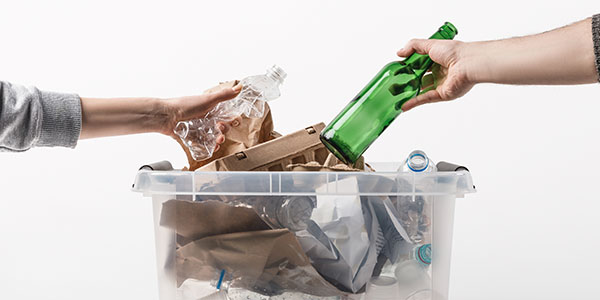
Recycle Glass in Your Curbside Pickup
The simplest way to recycle glass at home is to drop your glass in your recycling bin for curbside collection. Rinse your containers and set them in the bin on collection day. Unfortunately, this option is not available everywhere.
In recent years, some cities with single-stream recycling systems, where all recyclables are collected in the same bin, have stopped allowing glass because it can contaminate other recyclables. Check with your recycling and waste management provider or city services department to see if you can put glass in your recycling bin.
If glass is not accepted in your curbside container, there are other ways to recycle glass that are simple and efficient.
How to Recycle Glass Outside of Curbside Recycling
Communities that don’t have a curbside option for glass recycling will often set up other collection points, such as a recycling drop-off center.
Search for additional ways to recycle glass:
- Use GlassRecycles.org’s Glass Recycling Map to find a location that accepts glass near you.
- Find a redemption site if your state offers 5 or 10 cent deposits on recyclables.
- Contact your city services department or your county’s solid waste district for resources.
- Call your local recycling center and ask if they accept glass jars and bottles.

“What consumers should do is look at their local municipality’s website to see if public glass recycling locations are available. If not, search online to see if there is a glass recycling facility in your area. And if those options for recycling the glass don’t work, reusing glass is the next best option: try to find a local artist who might use the glass, or even someone with an Etsy store who is repurposing the glass for various products.”
Jason Utgaard, Momentum Recycling
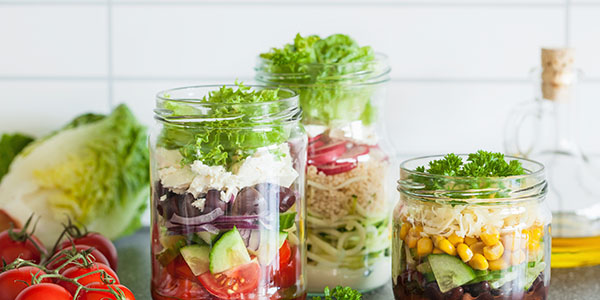
Find Creative Uses for Glass Bottles and Jars
If you don’t have curbside glass recycling or a drop-off location near you, find a creative way to recycle glass bottles and jars by upcycling or reusing them around your home.
How to recycle glass bottles:
- Carry a glass bottle as a reusable water bottle.
- Use a glass bottle as a candle holder inside or on the patio.
- Create mosaic art with broken pieces of colored glass bottles.
How to recycle glass jars:
- Use them as storage containers for leftovers or packed lunches.
- Build a garden in a glass jar.
- Use them as water, juice and beer glasses at home.
- Use jars as flower vases.
Knowing the right way to recycle glass at home helps conserve natural resources and keeps trash collectors safe. With these glass recycling tips and FAQs, you’ll be able to do just that while also simplifying your recycling habits and reducing your carbon footprint.

